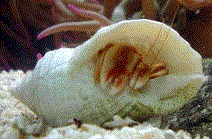
 |
 Hermit
Crabs
Hermit
Crabs
Experienced rockpoolers will know that not every snail shell moving across a pool is a live snail (gastropod mollusc). A careful eye will discover that an occasional snail is moving in a peculiar manner. The water on the shore will feel very cold early in the year, but a quick grab into a pool and you may be pleasantly surprised to discover two tiny orange claws sticking out of the aperture of the snail; a small Hermit Crab has taken up residence in the old shell.
Juvenile Hermit Crabs are common on rocky shores in all months of the year and there were many reports of these fascinating crustaceans in January 1997 when on many shores the fauna was exceptionally sparse. They were seen on the shore immediately following the period of exceptionally cold weather; the observations probably reflect human activity on the shore during the low spring tides, and the crabs are likely to have been present, unnoticed in the weeks prior to this.
Of the 15 or so species recorded regularly in British seas, the species known as the Common Hermit Crab, Pagurus bernhardus, is by far the commonest. If the major claw is on the right side, nearest the apex, most likely the Hermit Crab found between the tides is this species.
Squabbles
Continual fights and squabbles are the result of keeping several Hermit Crabs in the same aquarium. This can be explained by the need for the crab to protect its soft abdomen with a borrowed shell. . The crab adopts a univalve (snail-like) mollusc shell, which it carries around on its back throughout its life. Fights occur when the crabs dispute the available shells.
In 'Berry'
Like all decapod (ten-legged) crustaceans, Hermit Crabs mate, and afterwards the female carries the eggs underneath her coiled abdomen for several months when she is said to be 'in berry'. In the Common Hermit Crab the eggs hatch into larvae in the first two months of the year. At this hazardous stage they will undergo moults like all arthropods.
Young Hermits
The first planktonic stages are called zoea. Later when they develop claws (chelae) they are termed megalopa, before they settle on the sea floor and and search around for a gastropod shell to inhabit. Hermit Crabs are widespread on different demersal habitats, and the choice of shell depends on what is available. Pheasant Shells, Tricolia pullus, and Little Netted Dogwhelk Shells, Hinia incrassata, are a popular early choice on mid-Sussex shores. These shells can be less than 10 mm high, and as Hermit Crabs continue to moult and grow like other crabs, they need to embark on a constant quest for new and larger shells to inhabit.
Different Shells
In most cases they will use the shells of dead snails, but the squabbles for possession of a shell already occupied by a crab occur frequently in the wild. A Hermit Crab dispossessed of its home by a more aggressive crab of the same species is vulnerable to attack by its many enemies, and must find another shell quickly. It is fun to discover exactly what species of gastropod mollusc the inhabited shell used to belong to. In Sussex, the shells of the Periwinkle, Littorina littorea, as well as the Grey Topshell, Gibbula cineraria, and the Common Netted Dogwhelk, Hinia reticulata, are often occupied. Common Hermit Crabs will eventually grow large enough to occupy the commodious shelter of the Common Whelk, Buccinum undatum, This is the largest gastropod found in the shallow seas around the British Isles.
One of the most fascinating aspects of Hermit Crab behaviour is their association with other animals. Acorn Barnacles, tubeworms and hydroids will frequently settle on the outside of the shell. And one species of hydroid, Hydractinia echinata, is found on their shells and nowhere else. A ragworm, Nereis fucata, even resides in the spiral end of the larger whelk shells, poking its head out to feed on the fragments of the crab's meal.
However, the most spectacular of the commensal relationships is the sharing of the shell with a species of sea anemone. One anemone species that is found on large Hermit Crabs in the south and west only is the brownish Calliactis parasitica. The sea anemone is the active partner in the relationship with this species of Hermit Crab. Another species of Hermit Crab called Pagurus prideauxi shares a mutual relationship with the Cloak Anemone, Adamsia palliata.
Hermit Crabs are omnivorous
scavengers, picking up scraps from the surface of rocks and shredding larger
items. They also filter feed, extracting living plankton from the sea on
fine setae and other appendages.
Classification
Hermit Crabs are classified
in the infraorder Anomura of the order Decapoda
in the subphylum Crustacea. They are not true crabs like the Brachyura
and can be differentiated by the reduced rear pair of legs, which can be
seen when the Hermit Crab changes shells.
 |
 |
Photograph showing the reduced fifth pair of legs
Hermit
Crabs (Isle of Wight) including Pagurus cuanensis
on
Luke Richards' web pages
Hermit Crabs for the younger reader
British Marine Life
Study Society Crustacean Page 1
|
|
|
News 2000 |
Membership Form |
|